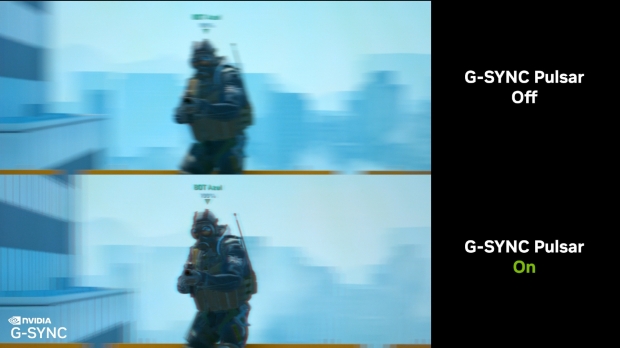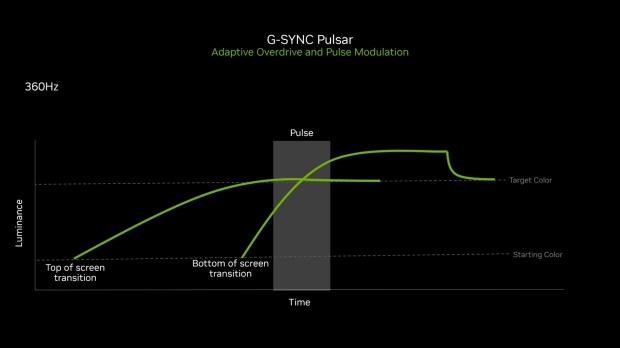Some truly impressive high refresh-rate displays have been announced and shown at CES 2024, like the new Alienware AW3225QF, one of the world's first 240Hz 4K OLED gaming monitors.

NVIDIA G-SYNC Pulsar improves motion clarity with VRR enabled, image credit: NVIDIA.
And with the very best displays featuring NVIDIA G-SYNC, G-SYNC ULTIMATE, and G-SYNC Compatible VRR technology, NVIDIA is announcing the latest evolution of its cutting-edge variable refresh rate tech - G-SYNC Pulsar.
NVIDIA is calling G-SYNC Pulsar the next evolution of Variable Refresh Rate (VRR) technology thanks to adding variable frequency strobing to improve motion clarity dramatically. With G-SYNC Pulsar off, a fast-moving image can look blurry even on a high refresh-rate display. With G-SYNC Pular enabled, that image is now crisp and clear, boosting the "effective motion clarity to over 1000Hz."
G-SYNC Pulsar is similar to the NVIDIA G-SYNC ULMB 2 tech we saw at Computex 2023, except that it combines the clarity Ultra Low Motion Blur with the smooth visuals of VRR performance. NVIDIA has a whole blog post detailing how Pulsar works, with the key being two innovations that the G-SYNC team has been working towards for over a decade - Adaptive Overdrive and Pulse Modulation.

A look at how G-SYNC Pulsar works, image credit: NVIDIA.
Adaptive Overdrive "adjusts the rate at which pixels transition from one color to another, a vital technique to reduce motion blur and ghosting." Pulse Modulation solves the VRR issue of a fluctuating refresh rate by modulating "overdrive based on both screen location and refresh rate." It also intelligently controls brightness and duration to maintain a comfortable, flicker-free image.
However, there's a catch. Adaptively tuning backlight pulses while keeping track of a game's render rate will require a dedicated G-SYNC chip - and a brand-new one, too. NVIDIA confirms that the first G-SYNC Pulsar capable display will be a new ASUS ROG Swift PG27 Series G-SYNC gaming monitor launching later this year.
All the NVIDIA news from CES 2024.
- Read more: GeForce RTX 4070, RTX 4070 Ti, and RTX 4080 SUPER announced - pricing, specs, and performance!
- Read more: Studios like Tencent and Ubisoft are using NVIDIA ACE to create AI NPCs in upcoming games
- Read more: GeForce NOW is getting new Blizzard games, Day Passes, and G-SYNC technology
- Read more: GeForce RTX 4070 SUPER and RTX 4080 SUPER Founders Edition models look incredible in all black
- Read more: Twitch Enhanced Broadcasting allows for five concurrent streams with a single GeForce RTX GPU
- Read more: GeForce RTX 4070 SUPER Founders Edition unboxing
- Read more: New G-SYNC Pulsar technology brings impressive stutter-free, smooth, motion clarity to monitors
- Read more: Generative AI by iStock is commercially safe image generation powered by NVIDIA Picasso
- Read more: Half-Life 2 RTX gets a new stunning trailer, RTX Remix Open Beta launches later this month
- Read more: Horizon Forbidden West Complete Edition coming to PC 'Early 2024' with DLSS 3, DLAA, and Reflex



